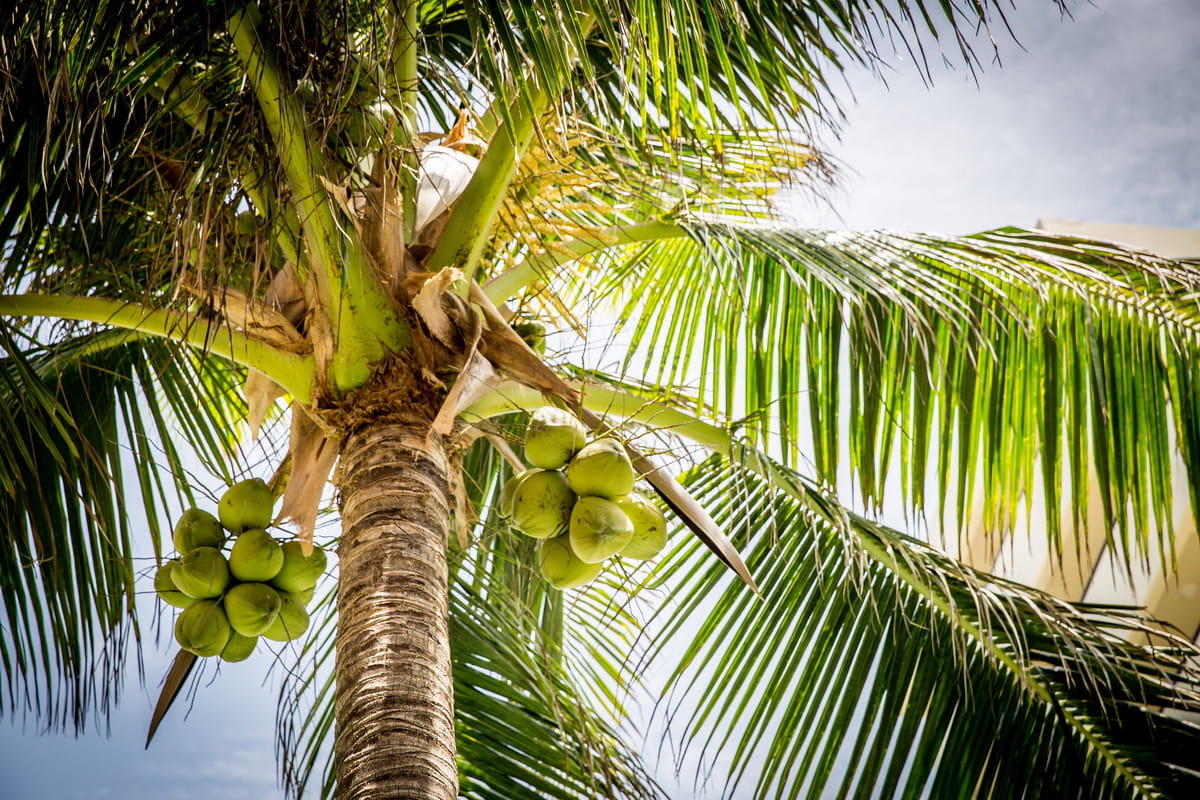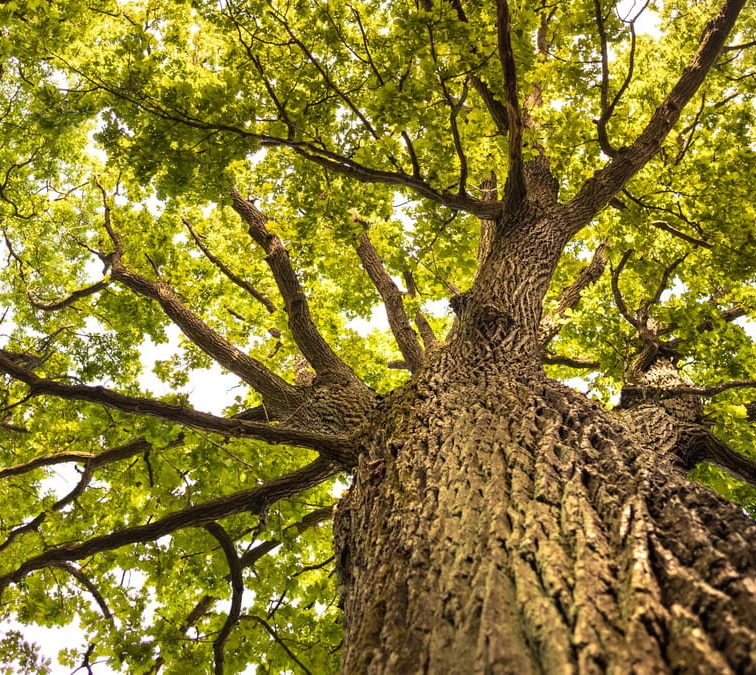Coconut trees, or Cocos nucifera, are not just tropical symbols but vital life-sustainers. Originating from the Indo-Pacific region, these trees have spread across the globe, deeply interwoven with various cultures and economies. Their remarkable utility ranges from nutritious coconuts, versatile wood, to ecological benefits like coastal erosion control.
With a lifespan of 60-80 years, a single tree can produce up to 200 coconuts annually, showcasing impressive productivity. Intriguingly, despite their strength and resilience, coconut trees face threats from environmental changes.
This article delves into the fascinating world of coconut trees, uncovering fun facts about coconut tree history, benefits, and the challenges they face, offering an intriguing journey through their significant role in various aspects of life and environment.
1. The Lifespan of a Coconut Tree: More Than Just Decades
Contrary to popular belief, coconut trees are not short-lived; they can live up to a century! These trees are an integral part of tropical ecosystems, providing food, income, and shelter for wildlife. They thrive best in warm, humid climates and can reach a staggering height of 30 meters.
The long lifespan of these trees makes them a staple in many communities, symbolizing strength and resilience. In ideal conditions, like the sandy soils of Sri Lanka’s Coconut Triangle, these trees flourish and can even surpass the 100-year mark.
2. Coconut Trees Can Float: A Journey Across Oceans
The buoyancy of coconut trees is a natural marvel, enabling their seeds to journey across oceans. This incredible feature played a critical role in the spread of coconut trees across the globe. The seeds can float for long distances over water, allowing them to colonize new areas and thus, spread the species far and wide.
This unique dispersal method has been key to the coconut tree’s global distribution, making it a common sight in many coastal regions around the world.

Image: pinimg.com
3. The Remarkable Height of Coconut Trees: Skyscrapers of the Tropics
Coconut trees are among the tallest palm trees in the world. On average, they typically reach heights of 50 to 80 feet, but some varieties can grow as tall as 100 feet.
There are different cultivars, such as the Maypan coconut palm, a hybrid that grows up to 60 feet, and the Chowghat Orange Dwarf, which reaches only 16 feet. The Tiptur tall coconut palm, originating in India, is known for its low maintenance and reliable supply of coconuts, reaching up to 80-100 feet.
4. The Ancient Origins of Coconut Trees: Tracing Back Millennia
Coconuts have a rich history and have been integral to various cultures, particularly in Austronesian societies. They were first domesticated by Austronesian peoples in Island Southeast Asia and played a crucial role in the long sea voyages of Austronesians.
Coconuts provided a portable source of food and water and materials for building outrigger boats. The species spread during the Neolithic period to the Pacific Islands, Madagascar, Comoros, and later along the Indian and Atlantic Oceans.
Theories about the evolutionary origin of the coconut are varied, with potential origins in Asia, South America, or Pacific islande.
5. Symbolism of Coconut Trees in Christianity
Although not traditionally associated with Christianity in the same way as palm fronds, coconut trees do hold a significant place in various cultures and religions. In some Christian communities, especially in tropical regions where coconut trees are abundant, they symbolize life, sustenance, and resilience.
The tree’s ability to provide food, drink, and shelter makes it a symbol of divine providence in some local Christian traditions.

Image: sportishka.com
6. Human Uses of Coconut Trees: A Multitude of Benefits
Coconut trees (Cocos nucifera) are a treasure trove of resources for humans, with every part of the tree being utilized. The meat and water of coconuts are nutritious, while coconut oil is used for cooking, health, and beauty benefits. The tree’s leaves and trunks are employed in building materials and handicrafts, and the husk fibers, known as coir, are used in items like ropes and mats.
This versatility extends to medicinal uses, where different parts of the tree provide natural remedies for various ailments. The widespread use of coconut trees in daily life highlights their immense value in both traditional and modern contexts.
7. Coco de Mer: World’s Largest Seed
The Coco de Mer palm tree, native to the Seychelles, produces the largest seed in the world, known as the sea coconut. These seeds can weigh over 60 pounds (around 27 kg) and measure up to 50 cm in diameter.
The Coco de Mer is distinct from the common coconut tree but shares the same family, Arecaceae. The enormity of the seed has made it a subject of fascination and a symbol of rarity and exotic.
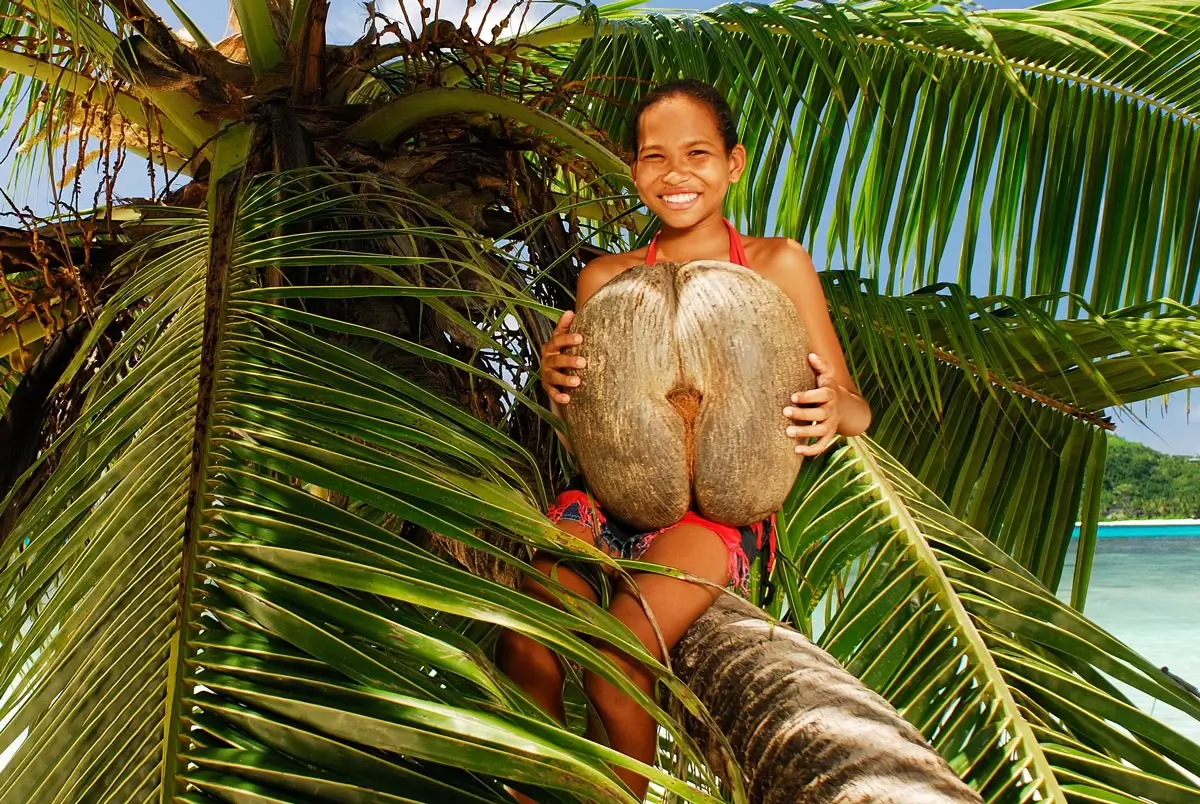
Coco de Mer coconut. Image: wildearthexpeditions.com
8. The Role of Coconut Trees in Coastal Protection
Coconut trees, particularly the Cocos nucifera species, play a significant role in coastal protection. Their presence in tropical coastal areas is not just for aesthetic value; they serve a crucial function in disaster management, especially in the event of tsunamis or coastal erosion. The structure and growth pattern of coconut trees make them effective in stabilizing the soil and reducing the impact of erosive forces along the coast.
In areas where coconut trees were abundant, the advancement of the high-tide mark was notably less compared to regions with fewer or no trees. This protective barrier provided by coconut trees is vital in preserving coastal land and reducing damage during natural disasters.
9. Endangered Coconut Tree Species: A Growing Concern
The survival of coconut trees, particularly in the Pacific Islands, is threatened by pests, diseases, and climate change. Initiatives like the ACIAR-supported project are crucial in protecting these trees.
Researchers have been collecting endangered coconut specimens to preserve genetic diversity and develop resistant varieties. This conservation effort is vital for the sustainability of coconut trees and the communities that rely on them.
Stored in Fiji’s Regional Genebank, these samples are used in breeding programs to combat biosecurity threats and adapt to climate changes.
10. Diverse Inhabitants of Coconut Trees
Coconut trees are home to a variety of wildlife, showcasing nature’s intricate ecosystem. Animals like monkeys, gorillas, and elephants interact with these trees, often using brute strength or ingenuity to access the nutritious coconuts. Coconut crabs and rhinoceros beetles are also attracted to these trees, the former for the coconuts and the latter for the sap.
Thus, the coconut tree stands as a bustling hub of activity, where each creature, from the smallest insect to the largest mammal, plays a crucial role in this vibrant ecosystem.

Image: nationalgeographic.com
11. Coconut Tree’s Strong Fibrous Root System
The coconut tree’s root system is fibrous and intricate, spreading outward to stabilize the tree and absorb nutrients. These roots can extend up to 9 feet deep, providing stability against strong winds and support for nutrient uptake. They also play a crucial role in soil aeration and drainage.
This robust root system is key to the coconut tree’s survival, especially in sandy and coastal environments.
12. Maximizing Yield: The Coconut Palm’s Productivity
A coconut palm can produce up to 75 fruits each year. This productivity begins when the tree is about 6-10 years old, peaking at 15-20 years. Factors like climate, soil quality, and tree health greatly influence this yield.
The high fruit output is vital for tropical economies, with the versatile coconut used in various industries.
13. Symbol of Maldives: The Coconut Tree
The Coconut Tree, or Dhivehi Ruh, is deeply rooted in Maldivian culture and ecology. Officially declared the National Tree of Maldives on July 25, 1985, it symbolizes the islanders’ harmony with nature.
This tree is essential in preventing coastal erosion with its robust root system, contributing to the ecosystem by providing habitat for fauna and enhancing soil fertility. Historically, it served multiple purposes, from boat-building to culinary uses, making it a cornerstone of Maldivian heritage.
Its image adorns the national emblem and currency, reflecting its integral role in the nation’s identity.
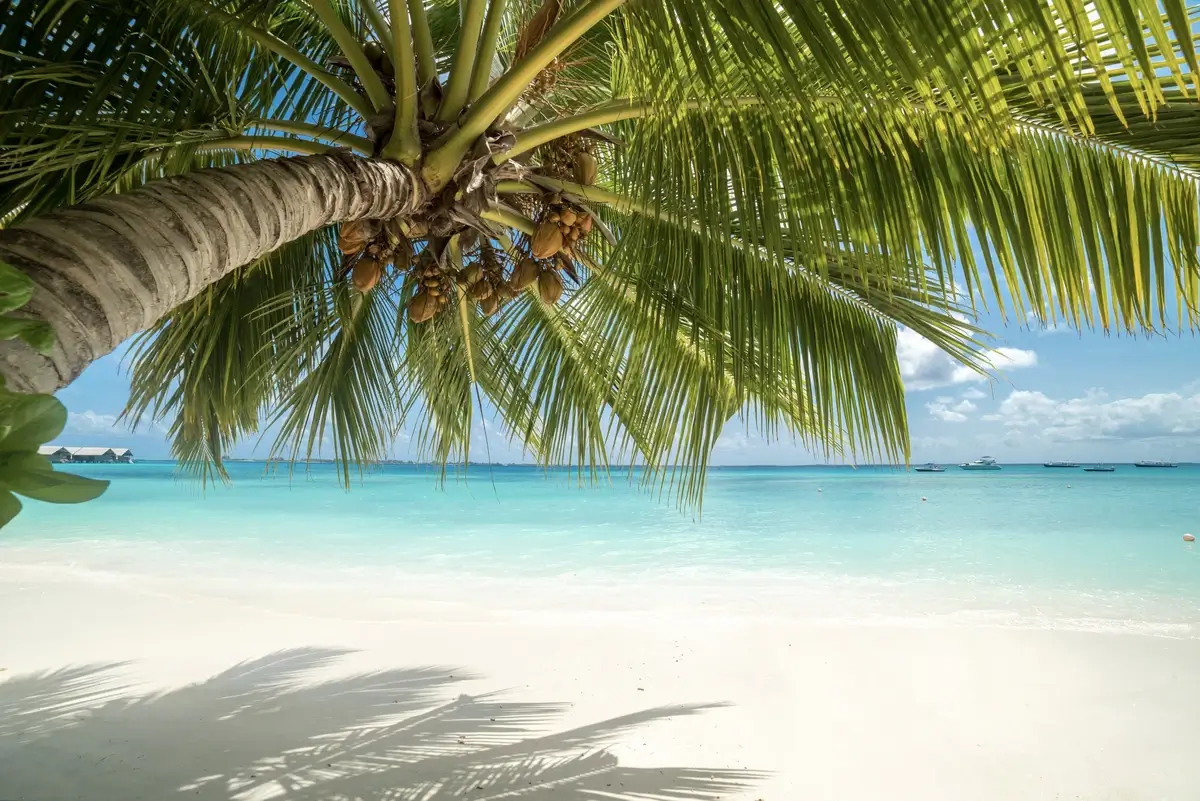
Coconut palms on a Maldivian beach. Image: X.com
14. Coconut Tree’s Journey to the Americas
Contrary to popular belief, the coconut tree is not native to the Americas. Early Spanish explorers did not encounter coconuts in the Caribbean during the late 15th and early 16th centuries.
Genetic studies reveal two distinct coconut groups: one from the Indonesian Pacific and the other from the Indian Ocean near India. Coconuts in the Caribbean belong to the Indian group, indicating they were brought to the Americas by colonizers from Africa’s west coast in the 16th century, not from Central America’s west coast.
This finding reshapes our understanding of the coconut’s global journey and its introduction to the America.
15. Early Fruit Production in Coconut Trees
Coconut trees, scientifically named Cocos nucifera, commence fruit production around 6-7 years of age. Their productivity peaks between 10 to 15 years, influenced by factors like climatic conditions, soil health, and cultivation practices.
Optimal growth and fruiting require exposure to full sunlight, regular fertilization, and proper pruning. These tropical trees, thriving in humid and well-drained soils, offer a unique adaptation to their environment.
The early onset of fruiting in coconut trees is vital for sustaining the economies of tropical regions, where they play a significant role in agriculture and industry.
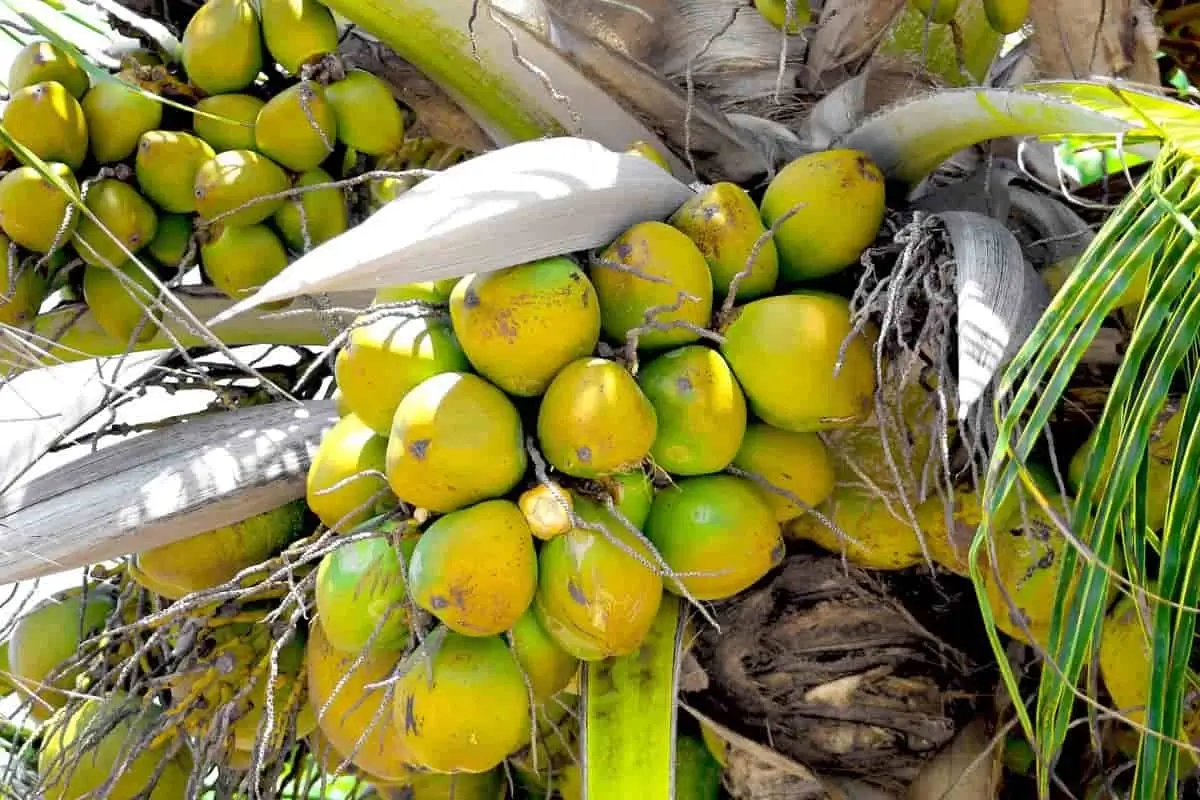
Image: gardeningtips.in
16. Ancient Maritime Journey of Coconut Trees
Coconut trees, or Cocos nucifera, have a rich and far-reaching history, believed to originate in the Indo-Pacific region or South America. They played a crucial role in the ancient Austronesian seafaring voyages, aiding in the colonization of remote islands across the Pacific and Indian Oceans.
The buoyant nature of coconuts allowed them to travel across vast marine distances, facilitating natural dispersal. Additionally, these trees provided essential resources such as food, water, and materials for building seafaring crafts. This significant role in maritime exploration and colonization highlights the coconut tree’s integral part in shaping human history, particularly in tropical coastal cultures.
17. Cultural Essence of Coconut Trees
Coconut trees, deeply woven into various cultures, symbolize life and abundance. Central to Hindu rituals, they embody purity and divine connection. These trees serve as a vital resource, providing food, shelter, and tools, enriching cultural heritage and traditions across tropical regions.
Revered as the ‘Tree of Life’, coconut trees represent resilience, sustenance, and are pivotal in numerous religious and cultural practices.
18. Coconut Trees: Guardians of Shorelines
Coconut trees are crucial in coastal erosion control. Their fibrous root systems stabilize sandy soils, protecting shorelines from erosion. Projects worldwide use coconut materials, like coir, for shoreline restoration. Coir logs, made from coconut husk fibers, are environmentally friendly and effective in trapping sediment and supporting vegetation growth.
This natural approach to shoreline protection not only preserves the coast but also fosters ecological balance, making coconut trees essential in combating coastal erosion and maintaining habitat integrity.
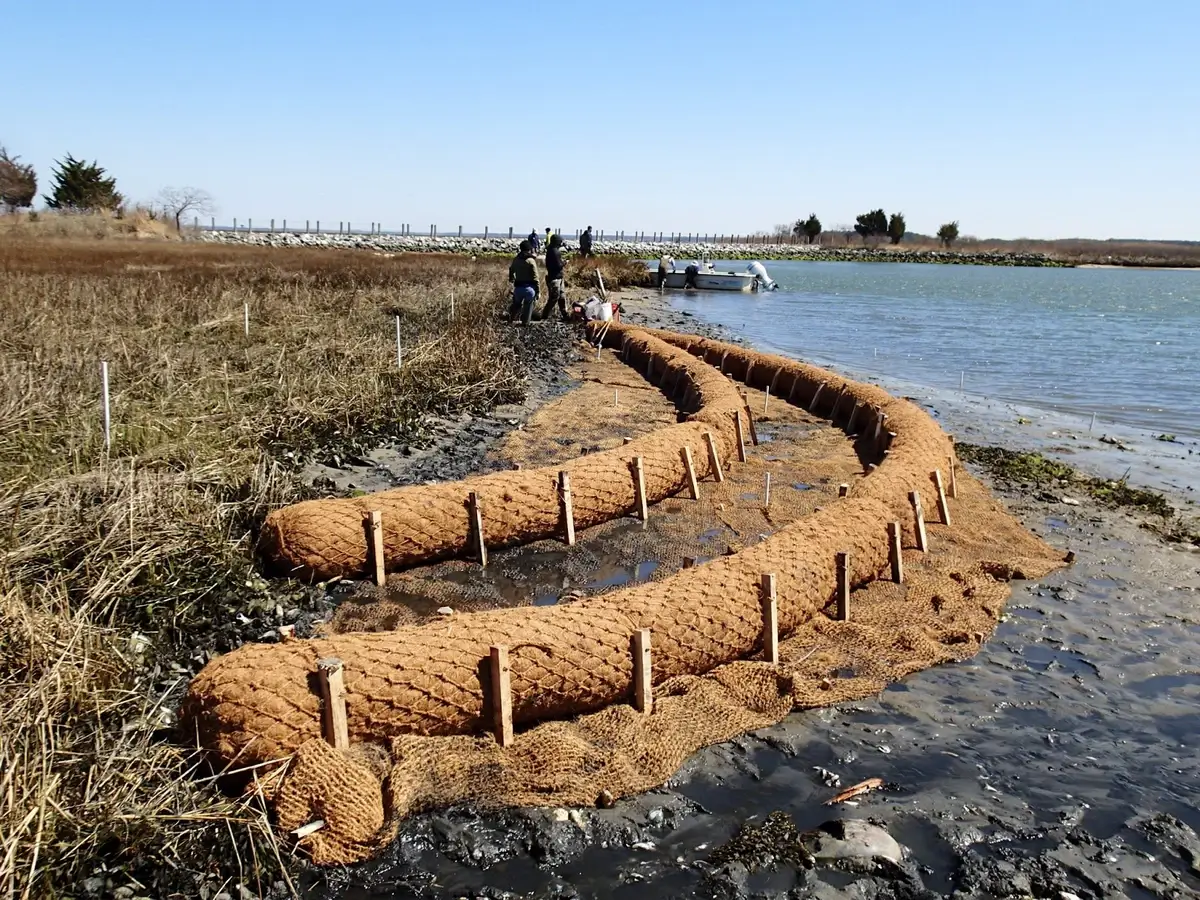
Shoreline fortified with coconut coir logs. Image: 4.bp.blogspot.com
19. The Diversity of Coconut Trees
Coconut trees, a single species known as Cocos nucifera, boast over 100 regional varieties and cultivars globally. These include both tall and dwarf types, with the former growing up to 30 meters and the latter being shorter and often used for landscaping. Hybrid varieties, a mix of tall and dwarf, produce coconuts of varied sizes and shapes, adding to the diversity.
These trees are cultivated worldwide for their fruit, leaves, husks, and oil, each serving multiple purposes in different cultures. Their adaptability to various climates and soils makes them a staple in tropical regions.
20. Unique Botanical Structure of Coconut Trees
Coconut trees, scientifically known as Cocos nucifera, are unique in their botanical structure. Unlike true trees, they lack secondary growth and tree rings. The trunk of a coconut tree is a cylindrical stipe, typically thin and often tilted.
Coconut trees are characterized by their tall, slender form, reaching heights between 40 to 100 feet. Their leaves are pinnate or palmate, with a length of 2-6 meters. These characteristics distinguish coconut palms from other tree species and contribute to their unique appearance in tropical landscape.
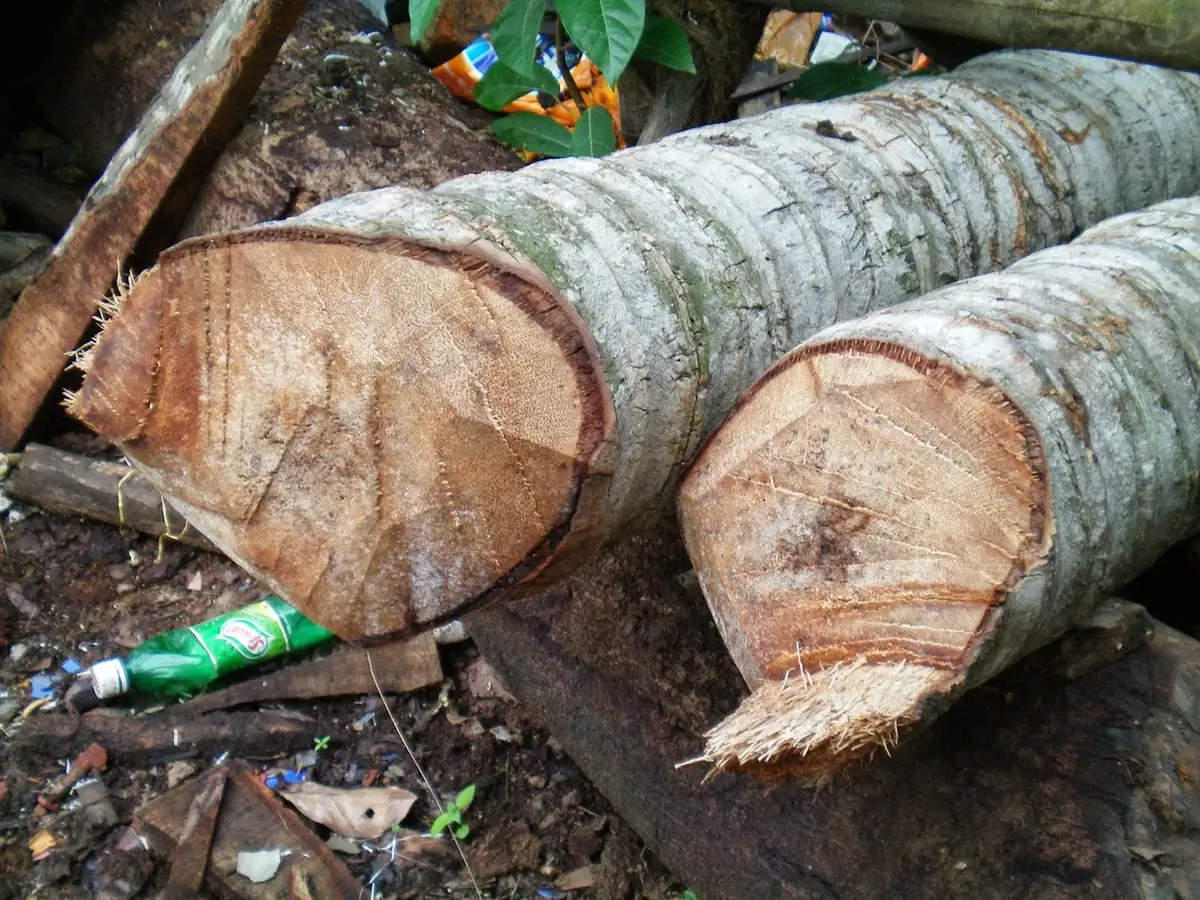
Image: martutie96.blogspot.com
21. Coconut Trees: Guardians of Ecosystems
Coconut trees (Cocos nucifera) are more than tropical symbols; they are pivotal in maintaining ecological balance. These trees influence soil nutrient levels, impacting local fauna.
Studies have shown that in regions where coconut trees dominate, herbivores like crabs and grasshoppers prefer consuming leaves from native forests, highlighting the coconut tree’s impact on the food chain. Moreover, coconut trees contribute significantly to carbon sequestration, combating climate change. Their deep root systems prevent soil erosion, especially in coastal areas, and offer protection against storms.
These trees also enhance biodiversity, providing habitats for birds and pollinators, and their various parts are used in traditional practices and modern applications.
FAQ
What are 3 benefits of coconut tree?
Coconut trees offer numerous benefits, including providing coconuts which can be used for food and oil, the tree’s wood and leaves are utilized for building and crafting materials, and they play a crucial role in ecological balance, especially in coastal regions.
What is the useful life of a coconut tree?
The useful life of a coconut tree spans approximately 60 to 80 years. During this time, they actively produce coconuts and other useful materials.
What is the second name of the coconut tree?
The scientific name of the coconut tree is Cocos nucifera, often referred to as the “tree of life” due to its wide range of uses.
Why are coconut trees so strong?
Coconut trees are strong due to their fibrous root system, which anchors them firmly into the soil, and their flexible trunks that can withstand strong winds and harsh coastal climates.
How many coconuts can a coconut tree produce?
A healthy and mature coconut tree can produce between 50 to 200 coconuts annually, depending on its variety and growing conditions.
How fast do coconut trees grow?
Coconut trees grow relatively fast compared to other trees. They can reach fruit-bearing maturity within 6 to 10 years and continue growing in height for several years thereafter.


